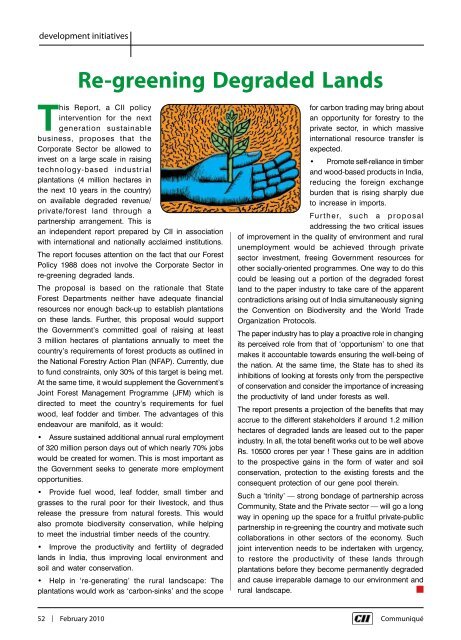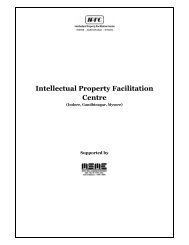CII Communique - February, 2010
CII Communique - February, 2010
CII Communique - February, 2010
You also want an ePaper? Increase the reach of your titles
YUMPU automatically turns print PDFs into web optimized ePapers that Google loves.
development initiatives<br />
Re-greening Degraded Lands<br />
This Report, a <strong>CII</strong> policy<br />
intervention for the next<br />
generation sustainable<br />
business, proposes that the<br />
Corporate Sector be allowed to<br />
invest on a large scale in raising<br />
technology-based industrial<br />
plantations (4 million hectares in<br />
the next 10 years in the country)<br />
on available degraded revenue/<br />
private/forest land through a<br />
partnership arrangement. This is<br />
an independent report prepared by <strong>CII</strong> in association<br />
with international and nationally acclaimed institutions.<br />
The report focuses attention on the fact that our Forest<br />
Policy 1988 does not involve the Corporate Sector in<br />
re-greening degraded lands.<br />
The proposal is based on the rationale that State<br />
Forest Departments neither have adequate financial<br />
resources nor enough back-up to establish plantations<br />
on these lands. Further, this proposal would support<br />
the Government’s committed goal of raising at least<br />
3 million hectares of plantations annually to meet the<br />
country’s requirements of forest products as outlined in<br />
the National Forestry Action Plan (NFAP). Currently, due<br />
to fund constraints, only 30% of this target is being met.<br />
At the same time, it would supplement the Government’s<br />
Joint Forest Management Programme (JFM) which is<br />
directed to meet the country’s requirements for fuel<br />
wood, leaf fodder and timber. The advantages of this<br />
endeavour are manifold, as it would:<br />
• Assure sustained additional annual rural employment<br />
of 320 million person days out of which nearly 70% jobs<br />
would be created for women. This is most important as<br />
the Government seeks to generate more employment<br />
opportunities.<br />
• Provide fuel wood, leaf fodder, small timber and<br />
grasses to the rural poor for their livestock, and thus<br />
release the pressure from natural forests. This would<br />
also promote biodiversity conservation, while helping<br />
to meet the industrial timber needs of the country.<br />
• Improve the productivity and fertility of degraded<br />
lands in India, thus improving local environment and<br />
soil and water conservation.<br />
• Help in ‘re-generating’ the rural landscape: The<br />
plantations would work as ‘carbon-sinks’ and the scope<br />
for carbon trading may bring about<br />
an opportunity for forestry to the<br />
private sector, in which massive<br />
international resource transfer is<br />
expected.<br />
• Promote self-reliance in timber<br />
and wood-based products in India,<br />
reducing the foreign exchange<br />
burden that is rising sharply due<br />
to increase in imports.<br />
Further, such a proposal<br />
addressing the two critical issues<br />
of improvement in the quality of environment and rural<br />
unemployment would be achieved through private<br />
sector investment, freeing Government resources for<br />
other socially-oriented programmes. One way to do this<br />
could be leasing out a portion of the degraded forest<br />
land to the paper industry to take care of the apparent<br />
contradictions arising out of India simultaneously signing<br />
the Convention on Biodiversity and the World Trade<br />
Organization Protocols.<br />
The paper industry has to play a proactive role in changing<br />
its perceived role from that of ‘opportunism’ to one that<br />
makes it accountable towards ensuring the well-being of<br />
the nation. At the same time, the State has to shed its<br />
inhibitions of looking at forests only from the perspective<br />
of conservation and consider the importance of increasing<br />
the productivity of land under forests as well.<br />
The report presents a projection of the benefits that may<br />
accrue to the different stakeholders if around 1.2 million<br />
hectares of degraded lands are leased out to the paper<br />
industry. In all, the total benefit works out to be well above<br />
Rs. 10500 crores per year ! These gains are in addition<br />
to the prospective gains in the form of water and soil<br />
conservation, protection to the existing forests and the<br />
consequent protection of our gene pool therein.<br />
Such a ‘trinity’ — strong bondage of partnership across<br />
Community, State and the Private sector — will go a long<br />
way in opening up the space for a fruitful private-public<br />
partnership in re-greening the country and motivate such<br />
collaborations in other sectors of the economy. Such<br />
joint intervention needs to be indertaken with urgency,<br />
to restore the productivity of these lands through<br />
plantations before they become permanently degraded<br />
and cause irreparable damage to our environment and<br />
rural landscape.<br />
52 | <strong>February</strong> <strong>2010</strong> Communiqué

















